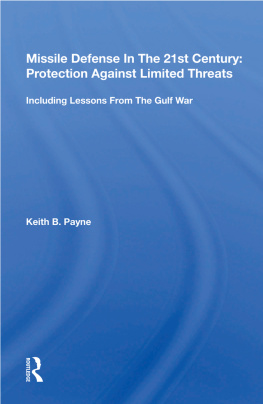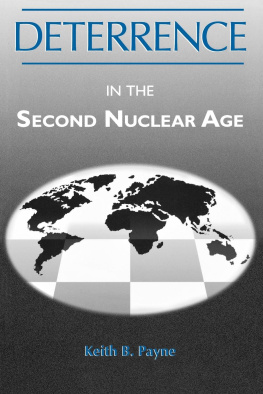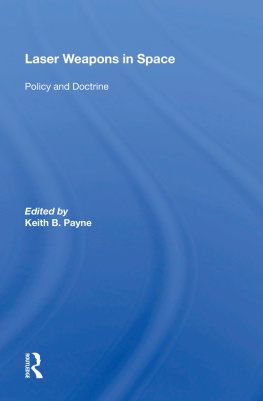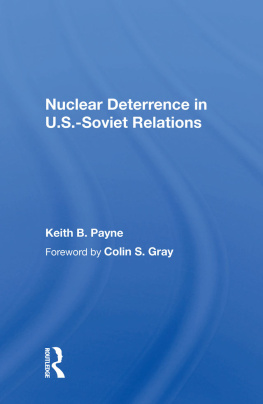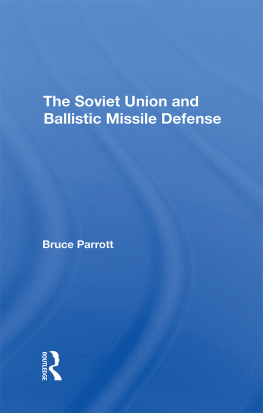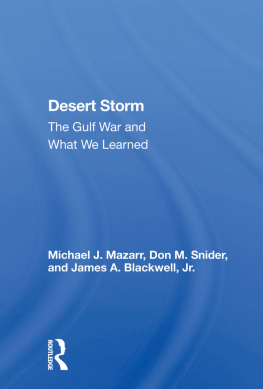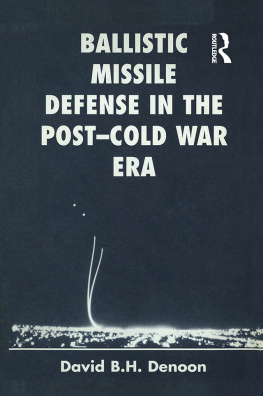Missile Defense In The 21st Century: Protection Against Limited Threats
Including Lessons From The Gulf War
by Keith B. Payne
First published 1991 by Westview Press
Published 2018 by Routledge
52 Vanderbilt Avenue, New York, NY 10017 2 Park
Square, Milton Park, Abingdon, Oxon OX14 4RN
Routledge is an imprint of the Taylor & Francis Group, an informa business
Copyright 1991 by National Institute For Public Policy
All rights reserved. No part of this book may be reprinted or reproduced or utilised in any form or by any electronic, mechanical, or other means, now known or hereafter invented, including photocopying and recording, or in any information storage or retrieval system, without permission in writing from the publishers.
Notice:
Product or corporate names may be trademarks or registered trademarks, and are used only for identification and explanation without intent to infringe.
Material has been drawn with permission from "Munich: Fifty Years After," in, Kenneth M. Jensen and David Wurmser, eds., The Meaning of Munich: Fifty Years Later (Washington, D.C.: U.S. Institute of Peace, 1990) and "Deterrence Without Defense: Gambling On Perfection," Strategic Review , (Winter 1989).
ISBN 13: 978-0-367-00442-2 (hbk)
For Elizabeth, A Little Patriot
Acknowledgements
The author would like to acknowledge and thank Dr. Kathleen Bailey, Dr. Roger Barnett, Kurt Guthe, Elizabeth Seeger Payne, and Chris Williams for their willingness to review the entire manuscript and provide helpful suggestions. Thanks are also due to Mr. Guthe, Col. John Kohout (USAF, Ret.), and Willis Stanley for contributing directly to a section of , two, and five, respectively. In addition, Mr. Stanley and Bernard Victory provided helpful research for several chapters. Finally, many thanks to Amy Bolton for her excellent work in preparing the manuscript. My appreciation is to all of the above for their assistance.
Contents
- Introduction
The Emerging Strategic Environment And Missile Defense - Chapter One
The Rationale For Missile Defense: Protection And Deterrence - Chapter Two
Global Protection Against Limited Strikes (GPALS) - Chapter Three
Missile Defenses In The Future Security EnvironmentEmerging Missile Threats And The Shadow Of The Gulf War - Chapter Four
Soviet Views On Proliferation And Missile Defense: Implications For The ABM Treaty and GPALS - Chapter Five
The Threat Of Accidental /Unauthorized Strikes And GPALS - Chapter Six
Alternatives To GPALS? - Chapter Seven
The Debate About Missile Defense: Some Preliminary Lessons From The Gulf War - Chapter Eight
Summary and Conclusions
- Introduction
The Emerging Strategic Environment And Missile Defense - Chapter One
The Rationale For Missile Defense: Protection And Deterrence - Chapter Two
Global Protection Against Limited Strikes (GPALS) - Chapter Three
Missile Defenses In The Future Security EnvironmentEmerging Missile Threats And The Shadow Of The Gulf War - Chapter Four
Soviet Views On Proliferation And Missile Defense: Implications For The ABM Treaty and GPALS - Chapter Five
The Threat Of Accidental /Unauthorized Strikes And GPALS - Chapter Six
Alternatives To GPALS? - Chapter Seven
The Debate About Missile Defense: Some Preliminary Lessons From The Gulf War - Chapter Eight
Summary and Conclusions
Guide
Figur es And Tables
The Emerging Strategic Environment And Missile Defense
KEITH B. PAYNE
It is commonplace to observe that the international system is changing. International relations always are in flux. Developments during the late 1980s and early 1990s, however, have been so dramatic and fast-paced that features of the international system familiar since immediately after World War II have been transformed beyond recognition. For example, Mikhail Gorbachev's need to invigorate the ossified Soviet political and economic structure, whatever the final outcome, unleashed a wave of change that swept over Eastern and Central Europe. It sparked the process of German unification, the liberalization of Eastern European countries, the collapse of the Warsaw Pact, and demands for independence by Soviet republics.
A less visible development of the 1980s was the accelerating proliferation of ballistic missiles, weapons of mass destruction, and other advanced military technology. This trend in proliferation began in the 1970s, gathered momentum during the 1980s, and shows no sign of abating.
Proliferation, when combined with the post-Cold War surfacing of regional hostilities, portends a security environment for the early 21st Century that will be much different than that of the mid-to-late 20th Century. For most of the Cold War period the only direct security threat to the United States was from the Soviet Union. With recent developments in the international system, however, the Soviet threat appears to have receded, while regional aggressors are emerging with significant military powerIraq's Saddam Hussein being only the most obvious. Rather than the traditional focus on the Soviet threat, future U.S. security considerations will have to include a much wider array of political and military concerns.
These developments have altered the basic international framework that had developed during the Cold War, and have compelled a review of long-held positions regarding security and foreign policy. This need to review past policy is particularly apparent with regard to missile defense. The U.S. debate about missile defense originated during the 1960s, with little subsequent change. The case for rejecting defenses, codified by the 1972 Anti-Ballistic Missile (ABM) Treaty, was a reflection of the strategic environment of the time: the arms competition with the Soviet Union and the U.S.-Soviet deterrence stalemate were the only serious considerations in the debate about missile defense. The 1980s SDI debate was largely a repetition of the earlier arguments.
However, the change in East-West relations and the proliferation of ballistic missiles are prominent features of an emerging strategic environment that will be far different from that which informed the basic case against missile defense in the 1960s. This book examines the implications of the emerging security environment for missile defense. In particular, it focuses on the recent redirection of the Strategic Defense Initiative towards a capability for global protection against limited strikes (GPALS). The questions of interest are whether missile defense against limited threats is a reasonable response to the changing security environment, and whether the decision to forego missile defenseand the ABM Treaty formalizing that decisionare now archaic. The book also identifies the valuable lessons concerning these questions provided by the Gulf War.
Chapter One
The Rationale For Missile Defense: Protection And Deterrence
President Ronald Reagan surprised the U.S. defense establishment on March 23, 1983 when he introduced the Strategic Defense Initiative (SDI). He spoke strongly of pursuing defensive protection for the U.S. and allied populations against nuclear attack. The President's stated goal of developing a comprehensive defense against long-range or "strategic" missile attack challenged the orthodoxy of U.S. policy on such defenses. With the signing of the ABM Treaty in 1972, the United States had rejected the option of deploying effective missile defenses. At the time, Nixon Administration officials claimed that preventing the nationwide deployment of ballistic missile defense (BMD) would help to end the "arms race" and "stabilize" the U.S.-Soviet deterrence relationship. As the preamble to the ABM Treaty states:

